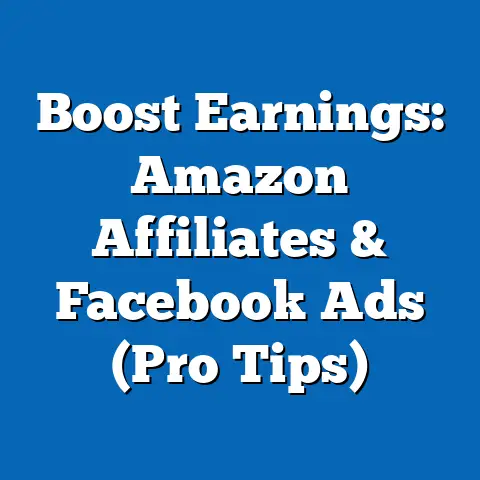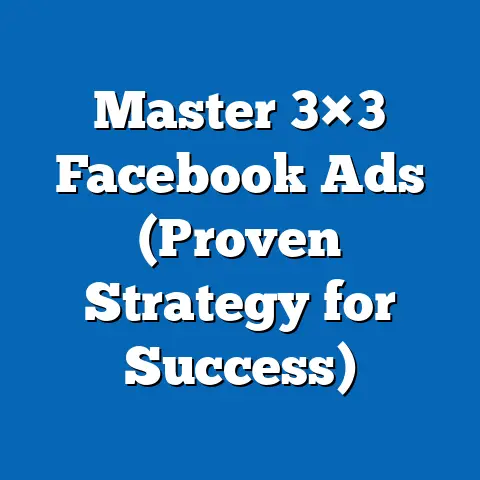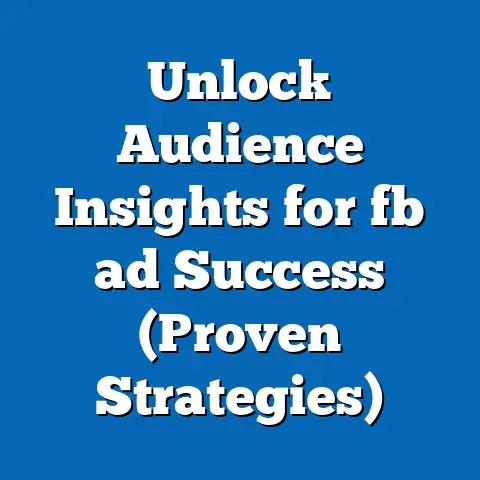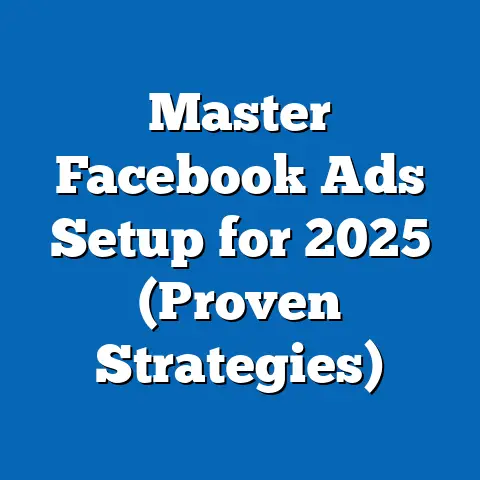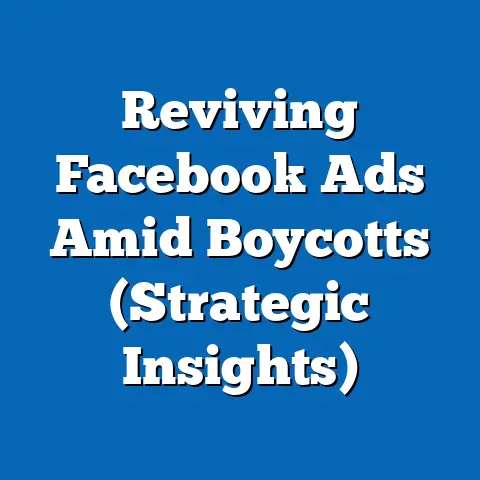Master ROI for Facebook Ads (Ultimate Guide)
I’ve always seen Facebook advertising as a bit of a high-stakes game. It’s not enough to just throw money at the platform and hope for the best. You need a strategy, a plan, and a keen understanding of how to measure and maximize your return on investment (ROI). Think of it like tending a garden. You can’t just scatter seeds and expect a bountiful harvest. You need to choose the right seeds, nurture them, monitor their growth, and protect them from pests. Similarly, in Facebook advertising, you must strategically develop your campaigns to optimize ROI. This guide is designed to be your comprehensive resource, walking you through every step of the process, from understanding the basics to implementing advanced strategies.
1. Understanding ROI in the Context of Facebook Ads
ROI, or Return on Investment, is the cornerstone of any successful business venture, and Facebook ads are no exception. Simply put, ROI measures the profitability of an investment relative to its cost. In the context of Facebook ads, it’s the ratio of the net profit generated from your advertising campaigns to the total cost of running those campaigns.
Why is ROI so important? Because it tells you whether your advertising efforts are actually paying off. Are you spending more money than you’re making? Are you achieving your desired results? ROI provides a clear, quantifiable answer to these questions.
To calculate ROI, I use this simple formula:
ROI = (Net Profit / Cost of Investment) x 100
For example, if you spend $1,000 on Facebook ads and generate $3,000 in revenue, your net profit is $2,000 ($3,000 – $1,000). Your ROI would then be:
ROI = ($2,000 / $1,000) x 100 = 200%
This means that for every dollar you spent on Facebook ads, you earned back two dollars in profit. A 200% ROI is generally considered excellent, but what constitutes a “good” ROI depends on your industry, business model, and specific campaign goals.
Typical Metrics Used to Measure ROI:
- Conversion Rate: The percentage of users who take a desired action (e.g., making a purchase, filling out a form) after clicking on your ad.
- Cost Per Acquisition (CPA): The cost of acquiring one new customer through your advertising efforts.
- Cost Per Click (CPC): The cost you pay each time someone clicks on your ad.
- Click-Through Rate (CTR): The percentage of users who click on your ad after seeing it.
- Return on Ad Spend (ROAS): Similar to ROI, but specifically focuses on the revenue generated from ad spend.
Understanding these metrics is crucial for interpreting your campaign performance and making data-driven decisions. I’ve found that regularly monitoring these metrics allows me to quickly identify areas for improvement and optimize my campaigns for maximum ROI.
Takeaway: ROI is a fundamental metric for evaluating the success of your Facebook ad campaigns. By understanding how to calculate and interpret it, you can make informed decisions about your advertising strategy and ensure that you’re getting the most bang for your buck.
2. Setting Clear Goals
Before even thinking about creating an ad, it’s imperative to define what you want to achieve. Are you looking to increase brand awareness, generate leads, drive sales, or something else entirely? Your goals will dictate your entire ad strategy, from targeting to creative.
Why are clear goals so important? Because they provide a roadmap for your campaign and a benchmark for measuring success. Without clear goals, you’re essentially wandering in the dark, unsure of where you’re going or how to get there.
Examples of Different Types of Goals:
- Brand Awareness: Increase the number of people who are familiar with your brand. Metrics to track include reach, impressions, and brand mentions.
- Lead Generation: Collect contact information from potential customers. Metrics to track include cost per lead (CPL) and lead quality.
- Sales Conversions: Drive direct sales of your products or services. Metrics to track include conversion rate, cost per acquisition (CPA), and revenue generated.
- Website Traffic: Increase the number of visitors to your website. Metrics to track include click-through rate (CTR) and website bounce rate.
- App Installs: Encourage users to download your mobile app. Metrics to track include cost per install (CPI) and app usage.
How Your Goals Influence Ad Strategy:
- Brand Awareness: Focus on reaching a broad audience with visually appealing ads that communicate your brand message.
- Lead Generation: Target a specific audience with lead magnet offers (e.g., free ebooks, webinars) and use lead capture forms.
- Sales Conversions: Target users who are most likely to purchase your products or services and use compelling product images and persuasive copy.
- Website Traffic: Target users who are interested in your niche and use engaging headlines and calls to action that encourage clicks.
- App Installs: Target users who are likely to be interested in your app and use app store preview videos and persuasive copy.
Takeaway: Setting clear, measurable goals is the first step towards maximizing ROI on Facebook ads. Your goals will guide your entire ad strategy and provide a framework for measuring success.
3. Identifying Your Target Audience
Imagine trying to sell snow shovels in Miami. You might get a few curious looks, but you’re unlikely to make many sales. Similarly, targeting the wrong audience on Facebook is a surefire way to waste your advertising budget and achieve poor ROI.
Why is audience targeting so important? Because it allows you to focus your advertising efforts on the people who are most likely to be interested in your products or services. By targeting the right audience, you can increase your conversion rates, lower your costs, and maximize your ROI.
Targeting Options Available on Facebook:
- Demographics: Target users based on age, gender, location, education, job title, and other demographic factors.
- Interests: Target users based on their interests, hobbies, and passions.
- Behaviors: Target users based on their online behavior, such as purchase history, website visits, and app usage.
- Custom Audiences: Target users who have already interacted with your business, such as website visitors, email subscribers, and customers.
- Lookalike Audiences: Target users who are similar to your existing customers or website visitors.
Tips for Creating Buyer Personas:
- Conduct Market Research: Gather data about your existing customers through surveys, interviews, and website analytics.
- Identify Common Traits: Look for patterns in your customer data, such as age, gender, location, interests, and behaviors.
- Create Fictional Profiles: Develop detailed profiles of your ideal customers, including their demographics, interests, motivations, and pain points.
- Use Your Personas to Guide Targeting: Use your buyer personas to inform your targeting decisions and create ads that resonate with your target audience.
I once worked with a client who was struggling to generate leads for their online course. After conducting thorough market research and creating detailed buyer personas, we discovered that their target audience was not who they initially thought it was. We adjusted our targeting accordingly, and within weeks, their lead generation costs plummeted, and their ROI skyrocketed.
Takeaway: Identifying and targeting the right audience is crucial for maximizing ROI on Facebook ads. By using Facebook’s powerful targeting options and creating detailed buyer personas, you can ensure that your ads are seen by the people who are most likely to be interested in your products or services.
4. Creating Compelling Ad Content
Even with perfect targeting, your ads will fall flat if the content isn’t engaging. Think of your ad as a mini-sales pitch. You need to grab attention, communicate value, and inspire action.
Elements of Effective Ad Copy and Design:
- Headline: The first thing people see, so make it attention-grabbing and relevant to your target audience.
- Body Text: Explain the benefits of your product or service and address any pain points your target audience may have.
- Visuals: Use high-quality images or videos that are visually appealing and relevant to your ad message.
- Call to Action (CTA): Tell people what you want them to do (e.g., “Learn More,” “Shop Now,” “Sign Up”).
The Role of Visuals, Headlines, and Calls to Action:
- Visuals: Capture attention, communicate your brand message, and showcase your product or service.
- Headlines: Grab attention, pique interest, and entice people to read the rest of your ad.
- Calls to Action: Tell people what you want them to do and make it easy for them to take action.
Examples of High-Performing Ads:
- Dollar Shave Club: Their ads are known for their humor and straightforward messaging. They use relatable scenarios and highlight the value of their subscription service.
- Airbnb: Their ads often feature stunning visuals of unique properties around the world, appealing to travelers’ sense of wanderlust.
- Nike: Their ads are inspirational and empowering, featuring athletes of all levels and encouraging people to push their limits.
Why These Ads Work:
- Relevance: They speak directly to the needs and interests of their target audience.
- Value: They clearly communicate the benefits of their product or service.
- Emotion: They evoke emotion and create a connection with the viewer.
- Clarity: They are easy to understand and have a clear call to action.
I once ran a campaign for a local restaurant that was struggling to attract new customers. We created a series of ads featuring mouthwatering photos of their signature dishes, along with compelling copy highlighting their unique atmosphere and friendly service. The ads generated a significant increase in website traffic and reservations, resulting in a substantial boost in revenue for the restaurant.
Takeaway: Creating compelling ad content is essential for driving engagement and conversions on Facebook. By focusing on relevance, value, emotion, and clarity, you can create ads that capture attention, communicate your message, and inspire action.
5. Choosing the Right Ad Format
Facebook offers a variety of ad formats, each with its own strengths and weaknesses. Choosing the right format for your campaign is crucial for maximizing ROI.
Different Ad Formats Available on Facebook:
- Image Ads: Simple and straightforward, ideal for showcasing products or services with a single image.
- Video Ads: Engaging and dynamic, ideal for telling stories and capturing attention.
- Carousel Ads: Showcase multiple products or services with a series of images or videos.
- Collection Ads: Feature a catalog of products with a visually appealing layout, ideal for e-commerce businesses.
- Instant Experience Ads: Full-screen, mobile-optimized ads that load instantly, providing an immersive experience.
- Lead Ads: Collect leads directly from Facebook with pre-filled forms, ideal for lead generation campaigns.
How Ad Formats Impact ROI:
- Video Ads: Often have higher engagement rates than image ads, but can be more expensive to produce.
- Carousel Ads: Allow you to showcase multiple products or services, potentially increasing conversion rates.
- Lead Ads: Simplify the lead generation process, potentially lowering your cost per lead.
Choosing the Right Format Based on Campaign Goals:
- Brand Awareness: Video ads and Instant Experience ads are ideal for capturing attention and communicating your brand message.
- Lead Generation: Lead ads are the most effective format for collecting leads directly from Facebook.
- Sales Conversions: Carousel ads and Collection ads are ideal for showcasing multiple products and driving sales.
- Website Traffic: Image ads and video ads with a clear call to action can effectively drive traffic to your website.
I once worked with an e-commerce client who was struggling to generate sales with their image ads. We switched to carousel ads, showcasing multiple products in a single ad, and saw a significant increase in conversion rates and revenue.
Takeaway: Choosing the right ad format is crucial for maximizing ROI on Facebook ads. By understanding the strengths and weaknesses of each format and aligning them with your campaign goals, you can create ads that are both engaging and effective.
6. Budgeting and Bidding Strategies
Setting the right budget and bidding strategy is a delicate balancing act. Spend too little, and your ads won’t reach enough people. Spend too much, and you’ll waste money on ineffective campaigns.
Budgeting Options:
- Daily Budget: The average amount you’re willing to spend each day.
- Lifetime Budget: The total amount you’re willing to spend over the entire duration of your campaign.
Implications for ROI:
- Daily Budget: Provides more control over your daily spend, but may limit your reach and potential conversions.
- Lifetime Budget: Allows Facebook to optimize your spend over the entire campaign duration, potentially increasing efficiency.
Bidding Strategies:
- Manual Bidding: You set the maximum amount you’re willing to pay for each click or impression.
- Automatic Bidding: Facebook automatically sets your bids to maximize your results within your budget.
How Bidding Strategies Affect Ad Performance and Costs:
- Manual Bidding: Provides more control over your costs, but requires more monitoring and optimization.
- Automatic Bidding: Simplifies the bidding process, but may result in higher costs if not properly monitored.
Testing and Adjusting Budgets:
- Start Small: Begin with a small budget and gradually increase it as you see positive results.
- Monitor Performance: Track your key metrics (e.g., CPA, conversion rate) and adjust your budget accordingly.
- A/B Test Different Budgets: Experiment with different budget levels to see which one delivers the best ROI.
I’ve always found that starting with a small daily budget and gradually increasing it as I see positive results is the best approach. This allows me to test different targeting options, ad creative, and bidding strategies without risking a large amount of money.
Takeaway: Setting the right budget and bidding strategy is crucial for maximizing ROI on Facebook ads. By understanding the different options available and testing different approaches, you can find the sweet spot that delivers the best results for your business.
7. Utilizing Facebook Pixel for Tracking
The Facebook Pixel is a small snippet of code that you place on your website to track user behavior. It’s like having a digital spy that reports back to Facebook about what people are doing on your site after they click on your ad.
Why is Facebook Pixel so important? Because it allows you to track conversions, optimize your campaigns, and retarget users who have already interacted with your business.
Setting Up Facebook Pixel:
- Create a Pixel: In Facebook Ads Manager, create a new pixel and name it.
- Install the Code: Place the pixel code on every page of your website.
- Set Up Events: Define specific events you want to track (e.g., “Add to Cart,” “Purchase,” “Lead”).
Benefits of Using Facebook Pixel:
- Conversion Tracking: Track which ads are driving conversions and which ones are not.
- Campaign Optimization: Optimize your campaigns based on conversion data.
- Retargeting: Retarget users who have already visited your website or interacted with your business.
- Lookalike Audiences: Create lookalike audiences based on your existing customers.
I’ve seen firsthand how the Facebook Pixel can transform a struggling campaign into a success story. By tracking conversions and retargeting users who have already shown interest in their products, businesses can significantly increase their ROI.
Takeaway: The Facebook Pixel is an essential tool for any serious Facebook advertiser. By tracking conversions, optimizing your campaigns, and retargeting users, you can significantly improve your ROI and drive more sales.
8. Analyzing Campaign Performance
Running Facebook ads is not a “set it and forget it” process. It requires constant monitoring, analysis, and optimization.
Why is regular performance analysis so important? Because it allows you to identify what’s working and what’s not, and make data-driven decisions to improve your ROI.
Key Metrics to Monitor:
- Reach: The number of people who saw your ad.
- Impressions: The number of times your ad was displayed.
- Click-Through Rate (CTR): The percentage of people who clicked on your ad after seeing it.
- Cost Per Click (CPC): The cost you pay each time someone clicks on your ad.
- Conversion Rate: The percentage of users who take a desired action (e.g., making a purchase, filling out a form) after clicking on your ad.
- Cost Per Acquisition (CPA): The cost of acquiring one new customer through your advertising efforts.
- Return on Ad Spend (ROAS): The revenue generated from your ad spend.
Tools Available for Analysis:
- Facebook Ads Manager: Provides a comprehensive overview of your campaign performance.
- Google Analytics: Tracks website traffic and user behavior.
- Third-Party Analytics Tools: Offer advanced analytics and reporting features.
Interpreting Data and Making Data-Driven Decisions:
- Identify Trends: Look for patterns in your data to identify what’s working and what’s not.
- Compare Different Ad Sets: Compare the performance of different ad sets to see which ones are delivering the best results.
- A/B Test Different Ad Creative: Experiment with different headlines, images, and calls to action to see which ones resonate best with your audience.
- Adjust Targeting: Refine your targeting based on the demographics, interests, and behaviors of your most valuable customers.
I always recommend creating a weekly report that summarizes your key metrics and highlights any significant trends or changes. This will help you stay on top of your campaign performance and make timely adjustments.
Takeaway: Regular performance analysis is essential for maximizing ROI on Facebook ads. By monitoring your key metrics, interpreting the data, and making data-driven decisions, you can continuously improve your campaign performance and drive more sales.
9. Scaling Successful Campaigns
Once you’ve identified a winning campaign, the next step is to scale it up without sacrificing ROI. This requires a strategic approach and a willingness to experiment.
Strategies for Scaling Campaigns:
- Increase Budget: Gradually increase your budget to reach a larger audience.
- Expand Targeting: Broaden your targeting to reach new potential customers.
- Create Lookalike Audiences: Target users who are similar to your existing customers.
- Replicate Successful Ad Sets: Duplicate your winning ad sets and target different audiences.
Importance of Incremental Testing:
- Avoid Making Large Changes: Make small, incremental changes to your campaigns and monitor the results.
- Test One Variable at a Time: When testing different targeting options or ad creative, only change one variable at a time so you can accurately measure the impact.
- Monitor Key Metrics: Track your key metrics (e.g., CPA, conversion rate) to ensure that your scaling efforts are not negatively impacting your ROI.
Takeaway: Scaling successful Facebook ad campaigns requires a strategic approach and a willingness to experiment. By gradually increasing your budget, expanding your targeting, and replicating your winning ad sets, you can reach a larger audience and drive more sales without sacrificing ROI.
10. Common Pitfalls to Avoid
Even the most experienced Facebook advertisers can fall victim to common pitfalls that can negatively impact ROI. Being aware of these mistakes and taking steps to avoid them can save you time, money, and frustration.
Common Mistakes Advertisers Make:
- Poor Audience Targeting: Targeting the wrong audience is a surefire way to waste your advertising budget.
- Neglecting A/B Testing: Failing to test different ad creative and targeting options can lead to ineffective campaigns.
- Ignoring Mobile Optimization: Many Facebook users access the platform on their mobile devices, so it’s crucial to optimize your ads for mobile viewing.
- Overlooking Ad Frequency: Showing your ads too frequently can annoy users and lead to ad fatigue.
- Ignoring Data Analysis: Failing to monitor your campaign performance and make data-driven decisions can lead to poor ROI.
How to Avoid These Pitfalls:
- Conduct Thorough Market Research: Develop detailed buyer personas to inform your targeting decisions.
- Embrace A/B Testing: Continuously test different ad creative and targeting options to identify what works best.
- Optimize for Mobile: Ensure that your ads are visually appealing and easy to read on mobile devices.
- Monitor Ad Frequency: Limit the number of times your ads are shown to each user.
- Analyze Your Data: Regularly monitor your campaign performance and make data-driven decisions to improve your ROI.
I’ve learned from my own mistakes and from observing the mistakes of others. By being aware of these common pitfalls and taking steps to avoid them, you can significantly improve your chances of success with Facebook advertising.
Takeaway: Avoiding common pitfalls is crucial for maintaining a healthy ROI on Facebook ads. By being aware of these mistakes and taking steps to avoid them, you can save time, money, and frustration.
Conclusion
Just as a gardener must be diligent and strategic to cultivate a thriving garden, advertisers must apply the same principles to their Facebook ad campaigns to achieve optimal ROI. By understanding the basics, setting clear goals, targeting the right audience, creating compelling ad content, choosing the right ad format, setting the right budget, utilizing the Facebook Pixel, analyzing your campaign performance, scaling successful campaigns, and avoiding common pitfalls, you can master ROI for Facebook ads and drive significant results for your business. Remember, Facebook advertising is not a “get rich quick” scheme. It requires hard work, dedication, and a willingness to learn and adapt. But with the right strategy and a little bit of patience, you can achieve remarkable results. Now, go forth and cultivate your own thriving Facebook ad garden!


